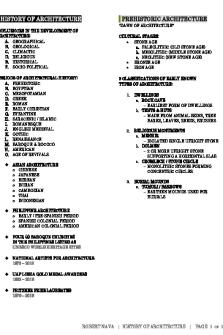Phil240 - Architecture of Doom PDF

| Title | Phil240 - Architecture of Doom |
|---|---|
| Author | Ariel Endsley |
| Course | Ethics |
| Institution | University of San Francisco |
| Pages | 2 |
| File Size | 67.7 KB |
| File Type | |
| Total Downloads | 31 |
| Total Views | 142 |
Summary
Download Phil240 - Architecture of Doom PDF
Description
1. Generally speaking, what did you think of the Architecture of Doom? What did you find interesting, or novel in it's approach to this historical context? a. The Architecture of Doom was a very interesting documentary because it provided historic images and pictures without an argumentative tone. This simplistic presentation portrayed Hitler’s ideas and challenged my personal difficulties in understanding how German citizens could have embraced his policies. The most compelling section detailed the progression of the Third Reich’s policies and overall justification of mass murder through propaganda and controlling the narrative. It was also interesting that his personal collection of art and architecture actually gives us a window into the mind of Hitler. For example, when planning the reconstruction of Berlin to fit Hilter’s aesthetic, Third Reich architects provided descriptions of the future ruins. This was interesting because it provided evidence of Hitler’s belief in the long-lasting impacts of his contributions. Furthermore, I was compelled by the link between Hitler's love of Greek and Roman antiquity and the strategies that he embraced in war (e.g. annihilation of the enemy, scorched earth policy, enslaving the conquered population, and destroying any records of the previous history of those conquered). 2. What were the key ideas presented in this documentary? Try to list at least 2 or 3 key ideas, and further explain each of your proposals with a clear and concise set of sentences. a. Adolf Hitler had an obsession with destroying anything other than classical art, aesthetics, and architecture. b. Jewish and Soviet art was considered to be degenerate and impure (e.g. degenerate art exhibitions depicted modern art as expressions of mental illness and physical degeneration was associated with artistic perversion). c. The primary principle of Natzi beauty was health which transformed aesthetic differences into medical problems. This laid the foundaiton for “biomedical pioneering” and justification of mass murder 3. Write a few paragraphs, attempting to relate the documentary's central ideas with this concern that Leopold's Land Ethic is "fascist". What connection(s) could possibly be made in this regard? The concepts presented in the Architecture of Doom and Leopold’s Land Ethic share three key features: the method, mission, and implications of their thesis. With regards to their method, it is interesting to note that both Leopold and Hitler presented their ideas to the world via a manifesto that used history as “evidence” for the need for their policies. Upon this need, both authors justified actions as moral when preserving or restoring something in danger of being lost. Although both authors share a mission of beauty preservation, Leopold’s Land Ethic
focuses on the biosphere while Hitler’s policies center around the “body” of the German people. There seems to be an assertion that actions governed by these principles signify a return to “old ways” and will result in the world flourishing once again. While seemingly well-intended, the implications of both manifestos have dire consequences. According to Leopold’s Land Ethic, an action is morally right when it preserves the integrity, stability, and beautify of the biosystem. Taken to the extreme, any action that preserves a biosystem is justifiable even if the action itself would have been considered immoral in other contexts. We see a similar thematic pattern play out in the policies of the Third Reich as euthanasia is justifiable within the context of preserving and purifying the integrity of the German people. Therefore, the government has a moral imperative to “sacrifice” the life of an individual who does not fit Hitler’s aesthetics. Furthermore, the Third Reich used propaganda to convince the German people that it was only a matter of time before the “mentally insane”, physically “deformed”, and intellectually “retarded” would vastly outnumber and overtake them. Deriving fear from this “threat” of elimination, Hilter normalized euthanization as a moral battle tactic because the end goal of preservation justified the means (e.g. mass murder). This concept is also evidenced within Leopold’s Land Ethic as it requires individuals to sacrifice when they pose a threat to or compromise the integrity, stability, and beauty of any ecosystem. In summary, both the Architecture of Doom and Leopold’s Land Ethic utilize the normative value of their fascist ideals in an attempt to persuade the common individual to embrace their policies....
Similar Free PDFs

Phil240 - Architecture of Doom
- 2 Pages

PHIL240 F2019 Syllabus
- 5 Pages

History of Architecture
- 139 Pages

Doom Bible - sdasds
- 79 Pages

Theory of Architecture- 2 (Concepts)
- 26 Pages
Popular Institutions
- Tinajero National High School - Annex
- Politeknik Caltex Riau
- Yokohama City University
- SGT University
- University of Al-Qadisiyah
- Divine Word College of Vigan
- Techniek College Rotterdam
- Universidade de Santiago
- Universiti Teknologi MARA Cawangan Johor Kampus Pasir Gudang
- Poltekkes Kemenkes Yogyakarta
- Baguio City National High School
- Colegio san marcos
- preparatoria uno
- Centro de Bachillerato Tecnológico Industrial y de Servicios No. 107
- Dalian Maritime University
- Quang Trung Secondary School
- Colegio Tecnológico en Informática
- Corporación Regional de Educación Superior
- Grupo CEDVA
- Dar Al Uloom University
- Centro de Estudios Preuniversitarios de la Universidad Nacional de Ingeniería
- 上智大学
- Aakash International School, Nuna Majara
- San Felipe Neri Catholic School
- Kang Chiao International School - New Taipei City
- Misamis Occidental National High School
- Institución Educativa Escuela Normal Juan Ladrilleros
- Kolehiyo ng Pantukan
- Batanes State College
- Instituto Continental
- Sekolah Menengah Kejuruan Kesehatan Kaltara (Tarakan)
- Colegio de La Inmaculada Concepcion - Cebu










